Three tennis looks, created by an unidentified French designer in 1926, the year women’s professional tennis was established.
Material Mode has a quibble.
After attending the exhibition The Rise of Sneaker Culture yesterday at the Brooklyn Museum, we left feeling that some of the exhibition labels that dealt with women’s participation in sports during the Teens and Twenties lacked some requisite nuance when speaking of sportswomen of the era. We had a hard pause when one of the labels proclaimed that before the Twenties women were not “allowed” to engage in athletic activities. Certainly, increasing numbers of women participated in sports in the Twenties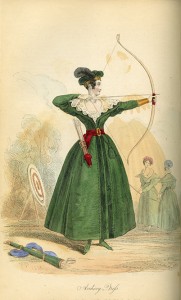 —physical exercise was even glamorized in the pages of mainstream fashion magazines. An interesting counter to the exhibition’s assertion that women were not playing sports prior to this time would be the myriad of primary sources in our collection that detail various forms of specialized sportswear for women which predate the Twenties, such as this archery dress dating to 1833.
—physical exercise was even glamorized in the pages of mainstream fashion magazines. An interesting counter to the exhibition’s assertion that women were not playing sports prior to this time would be the myriad of primary sources in our collection that detail various forms of specialized sportswear for women which predate the Twenties, such as this archery dress dating to 1833.
The fact of the matter is that by the Twenties, the demand for fashionable sportswear for women was so great it had been officially integrated into the offerings of haute couture houses; Jeanne Lanvin launched a dedicated Sports division in 1923 and Jean Patou had already established the reputation of his house partially based on the “real sports costumes designed with practical hard service in mind,” which were worn and adored by celebrity sports stars of the day, such as the French tennis sensation Suzanne Lenglen.
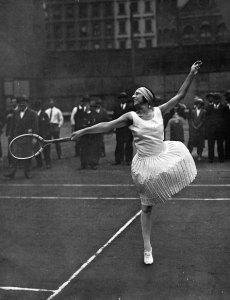
A media darling, Lenglen was renowned as much for her wardrobe as for her theatrical antics on and off court. Commonly covered in the fashion press and considered a measure of French chic, Lenglen’s on-court ensembles challenged traditional tennis attire by way of shorter skirts and bare shoulders. Even the tennis star’s undergarments were scrutinized by Women’s Wear Daily in 1926 when they published descriptions of the narrow, one-piece step-in foundation garment she wore while playing. Vanguard in many ways, including being the first female tennis player to turn professional, Lenglen was also an early participant in sports celebrity endorsement deals. More than half a century before the Air Jordans prominently showcased in the Sneaker Culture exhibition, Lenglen had entered into licensing deals with American manufacturers which allowed them to adapt and reproduce items in her personal wardrobe, which were then sold under the Suzanne Lenglen signature label. Many of these garments were adaptations or reproductions of couture sportswear ensembles created specifically for Lenglen by the likes of Patou and other French houses, this culture of American manufacturers copying French designers being a common industry practice at this time.
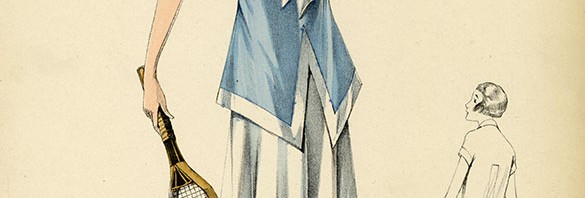

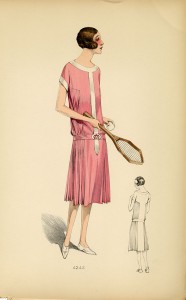
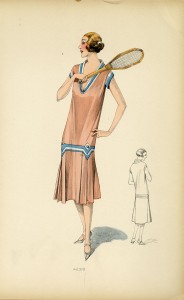
2 responses to “Tennis in the ’20s”
Excellent article. I wish there was less absolutism in costume history, too. Shades of grey are always more interesting, and frankly, usually closer to the truth.
Oh, if only I ruled the world, I could abolish all sloppy scholarship in museums. I think a lot of that sort of balderdash comes from a desire to make the theme of the exhibition fit all the materials (even ones that obviously don’t but were a part of a collection that couldn’t be left out), a string theory approach.
That and pure lazyness. “No one reads these things anyway, I am an Authority!”
History is the story of humans, who are inconsistent and varied. And that is MY string theory of history.